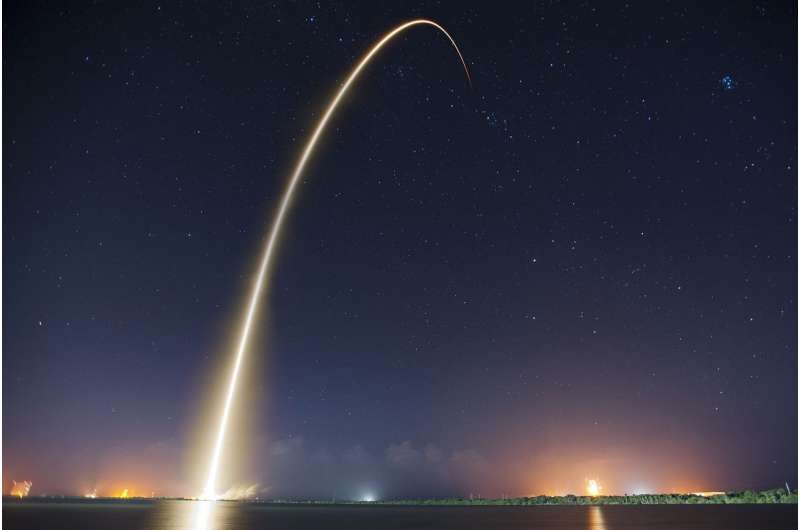
Copernical Team
Light rocks on deck, gray rocks in the hole: Sols 3966-3697
 Earth planning date: Wednesday, October 2, 2023: HiRISE images of Gale crater show that Curiosity is driving through a section of layered rocks on Mt. Sharp, and the layers consist of alternating bands of light and gray/dark rocks. What causes the color variation of these rocks that makes this terrain look banded from orbit?
It may relate to differences in the composition or chemistry of t
Earth planning date: Wednesday, October 2, 2023: HiRISE images of Gale crater show that Curiosity is driving through a section of layered rocks on Mt. Sharp, and the layers consist of alternating bands of light and gray/dark rocks. What causes the color variation of these rocks that makes this terrain look banded from orbit?
It may relate to differences in the composition or chemistry of t A prehistoric cosmic airburst preceded the advent of agriculture in the Levant
 Agriculture in Syria started with a bang 12,800 years ago as a fragmented comet slammed into the Earth's atmosphere. The explosion and subsequent environmental changes forced hunter-gatherers in the prehistoric settlement of Abu Hureyra to adopt agricultural practices to boost their chances for survival.
That's the assertion made by an international group of scientists in one of four relat
Agriculture in Syria started with a bang 12,800 years ago as a fragmented comet slammed into the Earth's atmosphere. The explosion and subsequent environmental changes forced hunter-gatherers in the prehistoric settlement of Abu Hureyra to adopt agricultural practices to boost their chances for survival.
That's the assertion made by an international group of scientists in one of four relat Orbit Fab appoints Chief Engineer, advances refueling system test capabilities
 Orbit Fab, the leading provider of on-orbit refueling services, has named industry veteran Kevin Smith as the company's Chief Engineer, who will lead the Systems, Electrical, Fluids, and Mechanical engineering teams and internal development, testing and overall readiness of RAFTI and GRIP in-space fueling systems.
Fresh off his most recent stint as Senior Propulsion Engineer at Astrobotic,
Orbit Fab, the leading provider of on-orbit refueling services, has named industry veteran Kevin Smith as the company's Chief Engineer, who will lead the Systems, Electrical, Fluids, and Mechanical engineering teams and internal development, testing and overall readiness of RAFTI and GRIP in-space fueling systems.
Fresh off his most recent stint as Senior Propulsion Engineer at Astrobotic, New center will lay groundwork for better space weather forecasts
 A new center led by CU Boulder will undertake research to make the region of space between Earth and the moon a little safer-potentially helping satellites navigate through this tumultuous and sometimes hazardous environment.
This summer, NASA announced that it had selected four Space Weather Centers of Excellence, including the Space Weather Operational Readiness Development (SWORD) cente
A new center led by CU Boulder will undertake research to make the region of space between Earth and the moon a little safer-potentially helping satellites navigate through this tumultuous and sometimes hazardous environment.
This summer, NASA announced that it had selected four Space Weather Centers of Excellence, including the Space Weather Operational Readiness Development (SWORD) cente Firefly Aerospace completes Blue Ghost Lunar Lander Structure
 Firefly Aerospace, an end-to-end space transportation company, has completed the development and assembly of its Blue Ghost lander structure and fluid systems, a critical milestone for Firefly's first lunar mission slated to land on the Moon in 2024 as part of NASA's Commercial Lunar Payload Services (CLPS) initiative. This mission is one of three task orders Firefly has won under NASA CLPS, acc
Firefly Aerospace, an end-to-end space transportation company, has completed the development and assembly of its Blue Ghost lander structure and fluid systems, a critical milestone for Firefly's first lunar mission slated to land on the Moon in 2024 as part of NASA's Commercial Lunar Payload Services (CLPS) initiative. This mission is one of three task orders Firefly has won under NASA CLPS, acc Massive low earth orbit communications satellites could disrupt astronomy
 Observations of the BlueWalker 3 prototype satellite show it is one of the brightest objects in the night sky, outshining all but the brightest stars.
Astronomers have raised concerns that without mitigation, groups of large satellites could disrupt our ability to observe the stars from Earth and perform radio astronomy.
Several companies are planning 'constellations' of satellites -
Observations of the BlueWalker 3 prototype satellite show it is one of the brightest objects in the night sky, outshining all but the brightest stars.
Astronomers have raised concerns that without mitigation, groups of large satellites could disrupt our ability to observe the stars from Earth and perform radio astronomy.
Several companies are planning 'constellations' of satellites - SpaceX aims for its 50th Space Coast launch this year

SpaceX is targeting its 50th Space Coast launch of the year with another Starlink mission from Cape Canaveral Space Force Station.
A Falcon 9 carrying 22 of the company's Starlink satellites is slated for liftoff from Canaveral's Space Launch Complex 40 at 10:45 p.m. with four backup opportunities from 11:38 p.m. until 1:57 a.m. overnight and six backup opportunities late Thursday from 10:29 p.m. until 1:49 a.m. early Friday.
Space Launch Delta 45's weather squadron forecasts a 50% chance for good conditions with 70% chance in event of a 24-hour delay.
The booster on this flight is making its eighth flight and will attempt a recovery landing on the droneship Just Read the Instructions in the Atlantic Ocean.
This would be SpaceX's 70th orbital launch of the year across all of its launch pads in Florida and California. It's the 40th from Cape Canaveral with the other 10 Space Coast launches coming from Kennedy Space Center.
SpaceX will have managed 50 of the 53 total Space Coast launches this year with two so far from United Launch Alliance and one from Relativity Space making up the rest.
Space needs better 'parking spots' to stay usable, and an engineer is finding them

Any mission headed to space needs a "parking spot" at its destination. But these parking spots, regions located on orbits, are quickly becoming occupied or more vulnerable to collisions.
Most objects launching to space are satellites, which can travel faster than 4 miles per second in the regions where they park. About 10 times the number of satellites currently in space are expected to launch by 2030. Simultaneously, satellite constellations are increasing in number and size. These are groups of satellites working together as a system, such as for enabling GPS, observation of Earth, internet access and other types of communications.
ESA and Swatch: a stellar partnership

A new collaboration between ESA and Swiss watchmaker Swatch allows space fans to design their own space-themed watch using stunning images from space telescopes.
Ozone hole goes large again

Measurements from the Copernicus Sentinel-5P satellite show that this year’s ozone hole over Antarctica is one of the biggest on record. The hole, which is what scientists call an ‘ozone depleting area,’ reached a size of 26 million sq km on 16 September 2023. This is roughly three times the size of Brazil.

